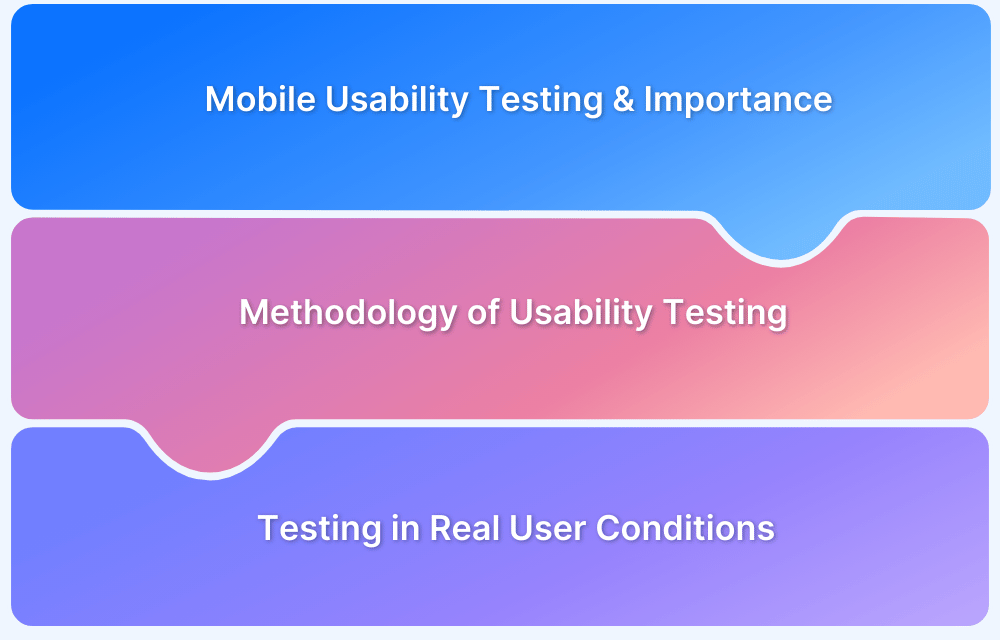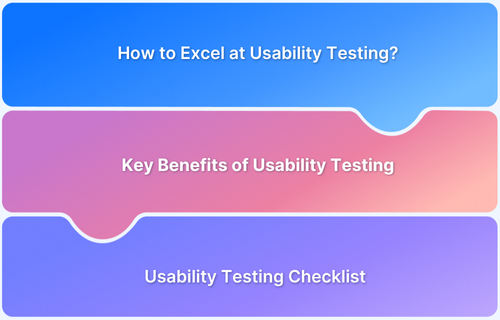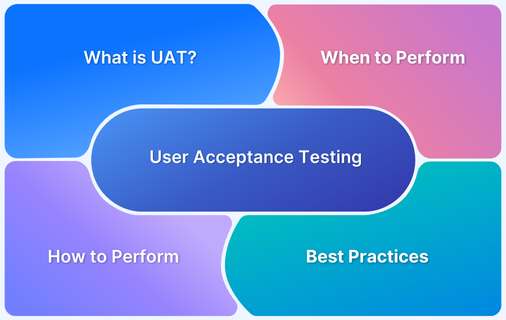User Testing vs Usability Testing
By Abishek Balakumar, Community Contributor - January 2, 2025
User Testing and Usability Testing are both crucial in developing successful digital products, but they focus on different aspects of the user experience.
User Testing and Usability Testing differ in focus and timing. User Testing, conducted early, evaluates whether a product meets the target audience’s needs. Usability Testing, performed later, examines how easily users interact with the product. It can be in-person or remote, with moderated, unmoderated, exploratory, and comparative methods. However, it can be time-consuming and costly, with small sample sizes that may not fully capture user feedback.
This article explores the key differences between user and usability testing, highlighting their unique roles in creating a successful and user-friendly product.
- Key Differences: Usability Testing vs User Testing
- What is User Testing?
- Benefits of User Testing
- Types of User Testing
- Top User Testing Tools
- When to Perform User Testing
- What is Usability Testing?
- Key Usability Testing Metrics
- Benefits of Usability Testing
- Types of Usability Testing
- Top Usability Testing Tools
- When to Perform Usability Testing
- Best Practices for User Testing
- Best Practices for Usability Testing
- User Testing vs Usability Testing: Which One to Pick?
- Why Should You Run User Testing and Usability Testing on Real Devices?
- Useful Resources for Usability Testing
- FAQs
Key Differences: Usability Testing vs User Testing
To clarify the differences between usability testing and user testing, the table below outlines their unique features:
| Parameter | User Testing | Usability Testing |
|---|---|---|
| Objective | Validate product concept and market fit | Evaluate ease of use and efficiency |
| Timing | Early stages: ideation and prototyping | Mid-to-late stages: functional prototypes or final product |
| Focus | User needs, expectations, and preferences | Task performance, error identification, and satisfaction |
| Participants | Potential users, market representatives | End-users or internal testers |
| Key Metrics | Qualitative insights, pain points, and feature priorities | Quantitative metrics like task success rates and error counts |
| Testing Methods | Surveys, interviews, A/B testing | Task-based scenarios, heuristic evaluations |
| Outcome | Refines product strategy and concept | Optimizes user interface (UI) and workflows |
Here is a summary of the key differences between user testing and usability testing:
- Objective: User testing validates whether the product concept meets the target audience’s needs, while usability testing evaluates how easily users can interact with the product and complete tasks effectively.
- Timing: User testing is conducted early in development, during ideation or prototyping, whereas usability testing is done later with functional prototypes or the final product.
- Focus: User testing focuses on understanding user preferences and refining the product concept. Usability testing focuses on task efficiency, error identification, and overall user satisfaction.
- Participants: User testing involves potential users or market representatives. Usability testing targets end-users or internal testers who interact directly with the product.
- Key Metrics & Methods: User testing gathers qualitative feedback through surveys, interviews, and A/B testing. Usability testing collects quantitative data such as task success rates and uses methods like task-based scenarios, eye tracking, and heatmaps.
- Outcome: User testing refines the product concept, while usability testing optimizes the user interface (UI) and improves usability.
What is User Testing?
User Testing is a method to gather insights directly from users to determine whether the product concept aligns with their needs. It involves observing user behaviors and listening to their feedback during structured or unstructured interactions with the product.
Also Read: What is User Acceptance Testing?
Benefits of User Testing
Below are some key benefits of user testing:
- Validates Product Concepts: Ensures alignment with market demands.
- Enhances User-Centered Design: Feedback drives user-first development.
- Reduces Development Risks: Early detection of major flaws saves time and cost.
- Builds Competitive Edge: Products tailored to user needs to stand out in the market.
Types of User Testing
Below are the common types of user testing:
- Exploratory Testing: Gauges user expectations during ideation stages.
- A/B Testing: Compares two variants to see which performs better.
- Beta Testing: Collects feedback from a small group of actual users.
- Remote Testing: Conducted virtually, often using platforms like BrowserStack.
Also Read: 10 Top Challenges of Remote Testing
Top User Testing Tools
Below are the top user testing tools:
1. BrowserStack: A cloud-based tool offering over 3,500 real devices and browsers for cross-platform testing, ideal for both user and usability testing scenarios.
Comprehensive and versatile, BrowserStack excels in replicating real user conditions, making it perfect for ensuring cross-device compatibility.
2. Optimal Workshop: Provides tools for card sorting and tree testing to improve information architecture. It is Excellent for website navigation insights but less suited for interactive testing.
3. Lookback: A remote testing tool enabling live observation and session recording. It is Ideal for capturing user reactions but lacks advanced analytics for deep insights.
4. UserZoom: A robust enterprise solution for task-based testing with detailed reporting. It is Best for large-scale testing but has a steep learning curve for new users.
When to Perform User Testing
Below are the scenarios of when you should perform user testing:
- Pre-Ideation: Validate the need for the product or feature.
- Prototype Stage: Gather feedback on design and functionality concepts.
- Post-Launch: Monitor user satisfaction and identify areas for improvement.
What is Usability Testing?
Usability testing is a systematic evaluation process to assess how effectively users can navigate and interact with a product or system. It identifies issues that hinder user experience, such as unclear workflows, inefficient task completions, or poor design.
Usability testing ensures that the product is intuitive and aligns with user expectations by observing real users performing specific tasks.
Also Read: How to Excel at Usability Testing?
Key Usability Testing Metrics
Below are some important usability testing metrics:
- Task Success Rate: Percentage of completed tasks without errors.
- Time on Task: Time taken to accomplish a specific task.
- Error Rate: Frequency of mistakes users encounter during interactions.
Benefits of Usability Testing
Below are some key benefits of usability testing:
- Enhanced User Satisfaction: By identifying and fixing pain points, usability testing creates seamless user experiences.
- Reduced Development Costs: Early detection of design flaws prevents costly post-launch fixes.
- Improved Accessibility: Ensures inclusivity for users with varying abilities.
- Better Retention Rates: A smoother user experience encourages customer loyalty.
- Data-Driven Insights: Empirical feedback drives decisions to improve design and functionality.
Types of Usability Testing
Below are the different types of usability testing:
- Moderated Testing: A facilitator guides the session, collecting real-time feedback.
- Unmoderated Testing: Participants complete tasks independently, typically using remote tools.
- Explorative Testing: Identifies usability gaps in the early stages of design.
- Comparative Testing: Compares the usability of two or more design versions.
- Remote Usability Testing: Conducted online using tools like BrowserStack to test products across devices and environments.
Top Usability Testing Tools
Below are some top usability testing tools:
1. BrowserStack: A robust, cloud-based platform that allows usability testing across over 3,500 real devices and browsers. It offers features like live testing and automation, making it ideal for remote usability testing.
For comprehensive cross-device testing, BrowserStack excels in replicating real-world scenarios but requires a tech-savvy approach for custom configurations.
Testing platforms like BrowserStack App Live and App Automate allow developers to test on real devices to ensure the above-mentioned key considerations are met.
2. Hotjar: Provides heatmaps, session recordings, and surveys to evaluate user behavior on web pages.
It is Excellent for visualizing interaction data but lacks in-depth cross-device testing capabilities.
3. Crazy Egg: Specializes in click tracking and scroll maps to assess website usability. It is Good for optimizing website layouts but unsuitable for interactive application testing.
4. Lyssna: Focused on design validation through quick preference tests and first-click testing. It is effective for early design feedback but limited to real-world task assessments.
When to Perform Usability Testing
Below are the scenarios when you should perform usability testing:
- Wireframe Phase: Validate the design’s logic and navigation paths.
- Prototype Stage: Test interactions before full-scale development.
- Post-Launch: Continuously refine features and address emerging usability challenges.
- Major Updates: Evaluate the usability impact of significant design or functionality changes.
Best Practices for User Testing
Below are some best practices for user testing:
- Define Clear Objectives: Establish what you aim to learn from the testing session.
- Recruit Representative Users: Involve participants who match the target audience.
- Use Scenarios: Frame real-life use cases for participants to engage with.
- Record Observations: Capture behavioral data and user feedback for later analysis.
- Iterate: Use insights to refine your product and retest as needed.
Best Practices for Usability Testing
Below are some best practices for usability testing:
- Test Early, Test Often: Catch usability issues before scaling development.
- Prioritize Realistic Tasks: Ensure scenarios reflect real user workflows.
- Leverage Cross-Device Testing: Tools like BrowserStack help replicate diverse user environments.
- Focus on Key Metrics: Track error rates and task completion times to measure effectiveness.
- Document Results Thoroughly: Share findings with your team to drive informed design decisions.
User Testing vs Usability Testing: Which One to Pick?
Choosing between user testing and usability testing depends on your development stage. In the early phases, user testing helps validate your product concept and understand user needs, preferences, and interests. As you near completion, usability testing focuses on optimizing user interactions and identifying issues that affect performance and satisfaction.
Both tests are crucial—user testing guides the product direction, while usability testing ensures a user-friendly final product. Depending on your goals, incorporating both can lead to a well-rounded, user-centered product.
Why Should You Run User Testing and Usability Testing on Real Devices?
Testing on real devices is critical in user and usability testing to ensure the product delivers a seamless experience in real-world scenarios.
Here’s why it matters and how BrowserStack simplifies this process:
- Replicates Real-World Conditions: Real devices accurately mimic user environments, including screen resolutions, touch responsiveness, and hardware limitations. Issues like battery drainage, memory usage, and app responsiveness can only be identified on real devices.
- Ensures Cross-Platform Compatibility: Real device testing validates performance across varying device models, operating systems, and browsers, ensuring consistent user experiences.
- Uncovers Device-Specific Bugs: Emulators often miss edge cases like specific OS bugs or device-specific gestures, which real devices easily highlight.
- Enhances Trust and Reliability: Testing on real devices guarantees that your product will perform well for end users, reducing support tickets and complaints.
BrowserStack Features for Real Device Testing
- Access to 3,500+ real devices and browsers for testing across multiple environments.
- Support for live and automated testing, enabling QA teams to test interactively or at scale.
- Real-time debugging tools allow testers to fix issues instantly.
- Seamless integration with CI/CD tools, streamlining development workflows.
Conclusion
Both user testing and usability testing are pivotal in ensuring that a product meets user needs and delivers a smooth and intuitive experience. While user testing focuses on validating concepts and addressing user expectations, usability testing dives into refining workflows and eliminating interaction friction. By leveraging tools like BrowserStack, teams can effectively conduct these tests on real devices, ensuring their products are ready for the dynamic digital landscape.
Useful Resources for Usability Testing
- What is Usability Testing?
- What is UX testing with example
- Website Usability Testing: A Beginner’s Guide
- How to Perform Usability Testing for Mobile Apps
- How to run Mobile Usability Tests for the best results
- How to Excel at Usability Testing?
- What is User Acceptance Testing?
FAQs
1. What is the difference between User Acceptance Testing (UAT) and Usability Testing?
UAT ensures the product meets business requirements and is ready for deployment, involving stakeholders or clients. Usability Testing focuses on user-friendliness and task efficiency, conducted with end-users to refine the experience.
UAT validates business logic, while usability testing ensures ease of interaction and user satisfaction.
2. What is the difference between Usability Testing and User Interface (UI) Testing?
Usability Testing evaluates how easily users can navigate and achieve their goals, focusing on overall user experience. UI Testing verifies that visual and interactive elements, like buttons and forms, function and appear correctly.
While usability testing focuses on the user journey, UI testing ensures the technical accuracy of the graphical interface.





